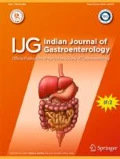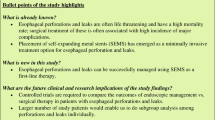Abstract
Background
Esophageal rupture, spontaneous or iatrogenic, is associated with significant morbidity and mortality. The current study aims at highlighting the various clinical scenarios, where esophageal fully covered self-expanding removable metal stents (FCSEMS) can be used in esophageal rupture.
Methods
In patients who underwent insertion of FCSEMS between January 2013 and June 2014, all data regarding demographics, indications, insertion, removal, and outcomes were studied retrospectively.
Results
Seven patients underwent the placement of esophageal covered SEMS. Two patients had Boerhaave syndrome, two had leak following the repair of aortic aneurysm, one had extensive esophageal injury following transesophageal echocardiography, one had carcinoma esophagus with tracheaesophageal fistula, and one had dehiscence of esophagogastric anastomosis. Stent insertion was successful in all the patients; one had stent migration which was managed endoscopically. Two patients died due to underlying illness; the rest had successful removal of stents after 8–10 weeks and good outcomes.
Conclusion
Esophageal FCSEMS placement is safe and effective modality in management of patients with esophageal rupture.




Similar content being viewed by others
References
Tilanus HW, Bossuyt P, Schattenkerk ME, Opertob H. Treatment of oesophageal perforation: a multivariate analysis. Br J Surg. 1991;78:582–5.
Adam DJ, Thompson AM, Walker WS, Cameron EW. Oesophagogastrectomy for iatrogenic perforation of oesophageal and cardiac carcinoma. Br J Surg. 1996;83:1429–32.
Tomaselli F, Maier A, Pinter H, Smolle-Juttner F. Management of iatrogenous esophagus perforation. Thorac Cardiovasc Surg. 2002;50:168–73.
Gelbmann CM, Ratiu NL, Rath HC, et al. Use of self-expandable plastic stents for the treatment of esophageal perforations and symptomatic anastomotic leaks. Endoscopy. 2004;36:695–9.
Roy-Choudhury SH, Nicholson AA, Wedgwood KR, et al. Symptomatic malignant gastroesophageal anastomotic leak: management with covered metallic esophageal stents. AJR Am J Roentgenol. 2001;176:161–5.
Chiesa R, Melissano G, Marone EM, et al. Aortooesophageal and aortobronchial fistulae following thoracic endovascular aortic repair: a national survey. Eur J Vasc Endovasc Surg. 2010;39:273–9.
Eggebrecht H, Baumgart D, Radecke K, et al. Aortoesophageal fistula secondary to stent-graft repair of the thoracic aorta. J Endovasc Ther. 2004;11:161–7.
De Praetere H, Lerut P, Johan M, et al. Esophageal necrosis after endoprosthesis for ruptured thoracoabdominal aneurysm type I: can long-segment stent grafting of the thoracoabdominal aorta induce transmural necrosis? Ann Vasc Surg. 2010;24:1137.e7–12.
Morisaki A, Hirai H, Sasaki Y, Hige K, Bito Y, Suehiro S. Aortoesophageal fistula after endovascular repair for aberrant right subclavian artery aneurysm. Ann Thorac Cardiovasc Surg. 2014;20 Suppl:790–3.
Eggebrecht H, Mehta RH, Dechene A, et al. Aortoesophageal fistula after thoracic aortic stent-graft placement: a rare but catastrophic complication of a novel emerging technique. JACC Cardiovasc Interv. 2009;2:570–6.
Pate JW, Walker WA, Cole FH Jr, Owen EW, Johnson WH. Spontaneous rupture of the esophagus: a 30-year experience. Ann Thorac Surg. 1989;47:689–92.
Herbella FA, Matone J, Del Grande JC. Eponyms in esophageal surgery, part 2. Dis Esophagus. 2005;18:4–16.
Dasari BV, Neely D, Kennedy A, et al. The role of esophageal stents in the management of esophageal anastomotic leaks and benign esophageal perforations. Ann Surg. 2014;259:852–60.
Schweigert M, Beattie R, Solymosi N, et al. Endoscopic stent insertion versus primary operative management for spontaneous rupture of the esophagus (Boerhaave syndrome): an international study comparing the outcome. Am Surg. 2013;79:634–40.
Gring C, Griffin BP. Transesophageal echocardiography. In: Topol EJ, editor. Textbook of Cardiovascular Medicine. 3rd ed. New York: Lippincott Williams & Wilkins; 2006. p. 868–71.
Min JK, Spencer KT, Furlong KT, et al. Clinical features of complications from transesophageal echocardiography: a single-center case series of 10,000 consecutive examinations. J Am Soc Echocardiogr. 2005;18:925–9.
Massey SR, Pitsis A, Mehta D, Callaway M. Oesophageal perforation following perioperative transoesophageal echocardiography. Br J Anaesth. 2000;84:643–6.
Duranceau A, Jamieson GG. Malignant tracheoesophageal fistula. Ann Thorac Surg. 1984;37:346–54.
Kim KR, Shin JH, Song HY, et al. Palliative treatment of malignant esophagopulmonary fistulas with covered expandable metallic stents. AJR Am J Roentgenol. 2009;193:W278–82.
Truong S, Bohm G, Klinge U, et al. Results after endoscopic treatment of postoperative upper gastrointestinal fistulas and leaks using combined Vicryl plug and fibrin glue. Surg Endosc. 2004;18:1105–8.
Lv Y, Yuan S, Yun J, et al. Management of intrathoracic leakage after radical total gastrectomy. J Thorac Dis. 2010;2:180–4.
Profili S, Feo CF, Cossu ML, et al. Effective management of intrathoracic anastomotic leak with covered self-expandable metal stents. Report on three cases. Emerg Radiol. 2008;15:57–60.
Fernández A, Vila JJ, Vázquez S, et al. Self-expanding plastic stents for the treatment of post-operative esophago-jejuno anastomosis leak. a case series study. Rev Esp Enferm Dig. 2010;102:704–10.
Inbar R, Santo E, Subchi Ael-A, et al. Insertion of removable self expanding metal stent as a treatment of post-operative leaks and perforations of esophagus and stomach. Isr Med Assoc J. 2011;13:230–3.
Acknowledgments
Mr Vipin Thomas
Author information
Authors and Affiliations
Corresponding author
Ethics declarations
Conflict of interest
MN, ZDS, NSC, RP, and RS declare that they have no conflict of interest.
Ethics statement
The authors declare that the study was performed in a manner that conforms to the Helsinki Declaration of 1975, as revised in 2000 and 2008 concerning human and animal rights, and the authors followed the policy concerning informed consent as shown on Springer.com.
Rights and permissions
About this article
Cite this article
Nasa, M., Sharma, Z.D., Choudhary, N.S. et al. Removable self-expanding metal stents insertion for the treatment of perforations and postoperative leaks of the esophagus. Indian J Gastroenterol 35, 101–105 (2016). https://doi.org/10.1007/s12664-016-0639-y
Received:
Accepted:
Published:
Issue Date:
DOI: https://doi.org/10.1007/s12664-016-0639-y




